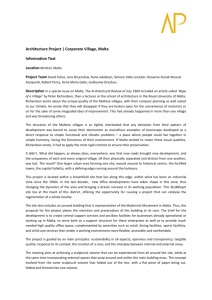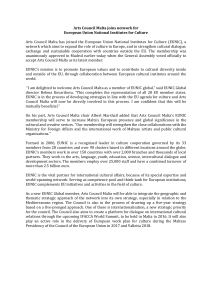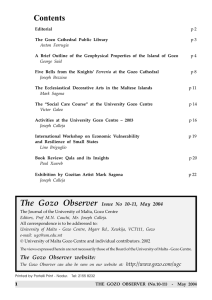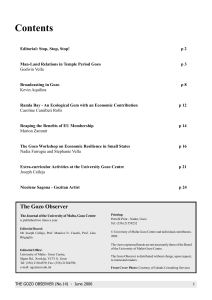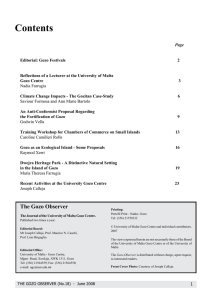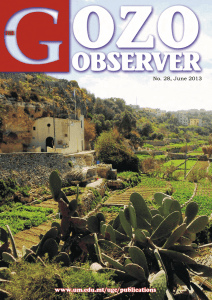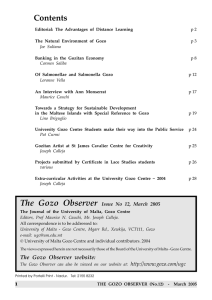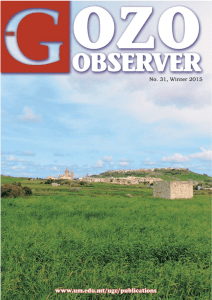Document 12425227
advertisement
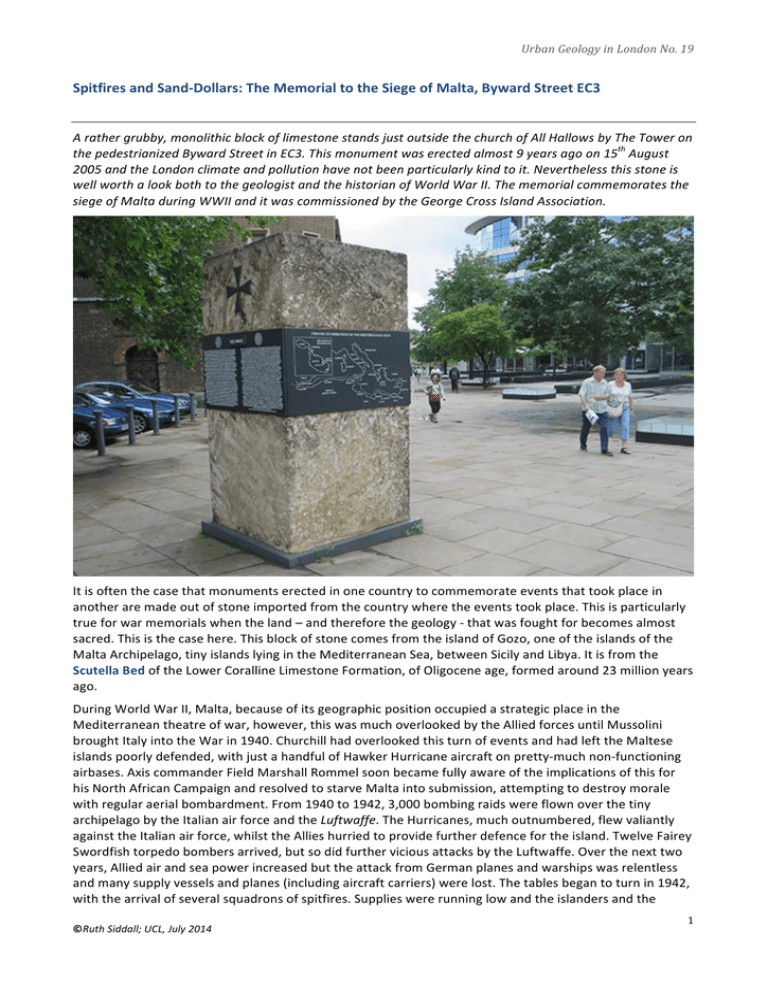
Urban Geology in London No. 19 Spitfires and Sand-­‐Dollars: The Memorial to the Siege of Malta, Byward Street EC3 A rather grubby, monolithic block of limestone stands just outside the church of All Hallows by The Tower on the pedestrianized Byward Street in EC3. This monument was erected almost 9 years ago on 15th August 2005 and the London climate and pollution have not been particularly kind to it. Nevertheless this stone is well worth a look both to the geologist and the historian of World War II. The memorial commemorates the siege of Malta during WWII and it was commissioned by the George Cross Island Association. It is often the case that monuments erected in one country to commemorate events that took place in another are made out of stone imported from the country where the events took place. This is particularly true for war memorials when the land – and therefore the geology -­‐ that was fought for becomes almost sacred. This is the case here. This block of stone comes from the island of Gozo, one of the islands of the Malta Archipelago, tiny islands lying in the Mediterranean Sea, between Sicily and Libya. It is from the Scutella Bed of the Lower Coralline Limestone Formation, of Oligocene age, formed around 23 million years ago. During World War II, Malta, because of its geographic position occupied a strategic place in the Mediterranean theatre of war, however, this was much overlooked by the Allied forces until Mussolini brought Italy into the War in 1940. Churchill had overlooked this turn of events and had left the Maltese islands poorly defended, with just a handful of Hawker Hurricane aircraft on pretty-­‐much non-­‐functioning airbases. Axis commander Field Marshall Rommel soon became fully aware of the implications of this for his North African Campaign and resolved to starve Malta into submission, attempting to destroy morale with regular aerial bombardment. From 1940 to 1942, 3,000 bombing raids were flown over the tiny archipelago by the Italian air force and the Luftwaffe. The Hurricanes, much outnumbered, flew valiantly against the Italian air force, whilst the Allies hurried to provide further defence for the island. Twelve Fairey Swordfish torpedo bombers arrived, but so did further vicious attacks by the Luftwaffe. Over the next two years, Allied air and sea power increased but the attack from German planes and warships was relentless and many supply vessels and planes (including aircraft carriers) were lost. The tables began to turn in 1942, with the arrival of several squadrons of spitfires. Supplies were running low and the islanders and the ©Ruth Siddall; UCL, July 2014 1 Urban Geology in London No. 19 airmen living there were close to starvation and undergoing a war of attrition. Nevertheless the islands clung on and remained unoccupied by Axis forces. The tables began to turn in the favour of the Allies after the victory over Rommel’s army at El Alamein. This allowed for supply convoys to reach Malta from North Africa in late 1942, effectively bringing an end to the siege. King George VI awarded the George Cross to the island on 15th April 1942 (see Holland, 2009). This memorial commemorates this siege and the award of the George Cross to Malta. Somewhat surprisingly it was the first to do so in the UK. A band of black dolerite panels (of unknown origin) are engraved with the story of the Islands during the war, plus commendations and maps. Iron Maltese crosses adorn two sides. A full transcription and description of the memorial is given on the London Remembers website1. On the main panel, it is stated that the stone used for the monument was brought from the island of Gozo. Malta’s Geology is fairly simple and straightforward and the geology and stratigraphy has been described by Pedley et al. (1976), Pedley et al. (2002) and Dart et al. (1993). The archipelago consist of three small islands, Malta (316 km2), Gozo (67 km2) and the tiny Comino (3.5 km2). These are tectonically uplifted horst blocks associated with the Tertiary Maltese Graben which allow a rare glimpse of the carbonate rocks of the Mediterranean Pelagian Platform. The stratigraphy consist of 5 main formations of Oligocene-­‐ Miocene age. These are; the Lower Coralline Limestone, the Globigerina Limestone, the Blue Clay Formation, the Greensand and the Upper Coralline Limestone. The shallow marine Lower Coralline Limestone is exposed on cliff sections on the south western coasts of Malta and Gozo as well as in some of the deep gorges on the islands. The golden-­‐yellow Globigerina Limestones are pelagic limestones rich in the foraminifera microfossil Globigerina sp. and are also known for the teeth of the giant shark Carcharadon megalodon and other phosphatic deposits. This formation is the most common stone in surface outcrop and indeed this lithology is the main building stone used on the island. It is known as Franka by quarrymen and builders (see Rothert et al., 2007). The Blue Clay and Greensands are fairly self descriptive and are not used for building. The Upper Coralline Limestone dominates the outcrop of Comino and is found in the north-­‐west of Malta and the east of Gozo and it too is worked as a building stone. The block of stone used for the Memorial here came from Gozo and close examination shows it to be a coarse grained, porous limestone, packed with sections through white fossils of the echinoid Scutella subrotunda (right). It is therefore reasonable to assume that it is derived from the Scutella Bed of the Lower Coralline Limestone. Maltese rocks are well known for their echinoid fauna (Wigglesworth, 1964) and this is particularly the case for the Lower Coralline Limestone Formation. The species Scutella subrotunda is particularly concentrated in the uppermost 10 m of this Formation, in coarse bioclastic limestones 1 London Remembers; http://www.londonremembers.com/memorials/malta-­‐siege ©Ruth Siddall; UCL, July 2014 2 Urban Geology in London No. 19 (Pedley et al., 1976), and the Scutella Bed marks the accepted top of the Lower Coralline Limestone. Some of the best exposures are in the ‘Azure Window’ natural arch on the western tip of Gozo. This area also shows evidence of recent and ancient quarrying activity. The geology of Gozo, after Wigglesworth (1964). The Azure Arch area is on the coast, west of San Lawrenz. The echinoid Scutella subrotunda is restricted to Oligocene and Miocene strata of the Mediterranean region. It is a Clypeasteroid echinoderm, similar to the modern ‘sand dollars’, which have tests circular to weakly pentagonal in shape and very flattened, and thus easily washed together in shoals. In this block we can see abundant cross-­‐sections through the tests which have a framework of sub-­‐vertical internal structures between the upper (slightly domed) and lower (flat) parts of the test (below). Scutella subrotunda2 In all, this monument is worth visiting for its historical significance and the unusual opportunity to see a building stone packed with echinoids in London. 2 Image source: Parent Géry, http://commons.wikimedia.org/wiki/File:Scutella_subrotunda_(Leske,_1778).JPG ©Ruth Siddall; UCL, July 2014 3 Urban Geology in London No. 19 The Azure Window natural arch, Gozo. Two figures on the top, to the left of the arch, provide scale. The arch is composed of Lower Coralline Limestone, with just a thin layer of Globigerina Limestone at the very top. The upper sections are the coarse grained limestones containing the Scutella Bed (Photograph by Laura Culbert). References & Further Reading Dart, C. J., Bosence, W. J. & McClay, K., R., 1993, Stratigraphy and structure of the Maltese graben system., Journal of the Geological Society, London., 150, 1153-­‐1166. George Cross Island Association: http://www.georgecrossisland.org.uk/about Holland, J., 2009, Fortress Malta: an island under siege 1940-­‐43., Phoenix., 512 pp. London Remembers; http://www.londonremembers.com/memorials/malta-­‐siege MIA, 2011, Marble Institute of America; Glossary of Stone Industry Terms; https://www.marble-­‐ institute.com/consumers/glossary.pdf Pedley, M., Clarke, M. H. & Galea, P., 2002, Limestone isles in a crystal sea: The geology of the Maltese islands. Malta, Publishers Enterprises Group (PEG) Ltd., 109 pp. Pedley. H. M., House, M. R. & Waugh, B., 1976, The Geology of Malta and Gozo. Proceedings of the Geologists’ Association., 87 (3), 325-­‐341. Rothert, E., Eggers, T., Cassar, J., Ruedrich, J., Fitzner, B., Siegesmund, S., 2007, Stone properties and weathering induced by salt crystallization of Maltese Globigerina Limestone., in: Prîkryl, R. & Smith, B. J. (eds) Building Stone Decay: From Diagnosis to Conservation., Geological Society, London, Special Publications, 271, 189–198. The Echinoid Directory; Natural History Museum: http://www.nhm.ac.uk/research-­‐ curation/research/projects/echinoid-­‐directory/taxa/taxon.jsp?id=825 Wigglesworth, J. C., 1964, The tertiary stratigraphy and echinoid palaeontology of Gozo, Malta, Unpublished PhD thesis, Durham University: http://etheses.dur.ac.uk/9003/ How to cite this article: Siddall, R, 2014, Spitfires and Sand-­‐Dollars: The Memorial to the Siege of Malta, Byward Street EC3; Urban Geology in London No. 19, http://www.ucl.ac.uk/~ucfbrxs/Homepage/walks/MaltaMemorial.pdf ©Ruth Siddall; UCL, July 2014 4 Urban Geology in London No. 19 Top: the stone used for the Siege of Malta Memorial, Field of View 20 cm. Below, the Memorial. ©Dr Ruth Siddall, University College London, Gower Street, London WC1E 6BT, UK: r.siddall@ucl.ac.uk Downloads from http://www.ucl.ac.uk/~ucfbrxs/Homepage/UrbanGeology.htm; Facebook | Cultural & Urban Geology | Twitter: #UrbanGeology ©Ruth Siddall; UCL, July 2014 5

